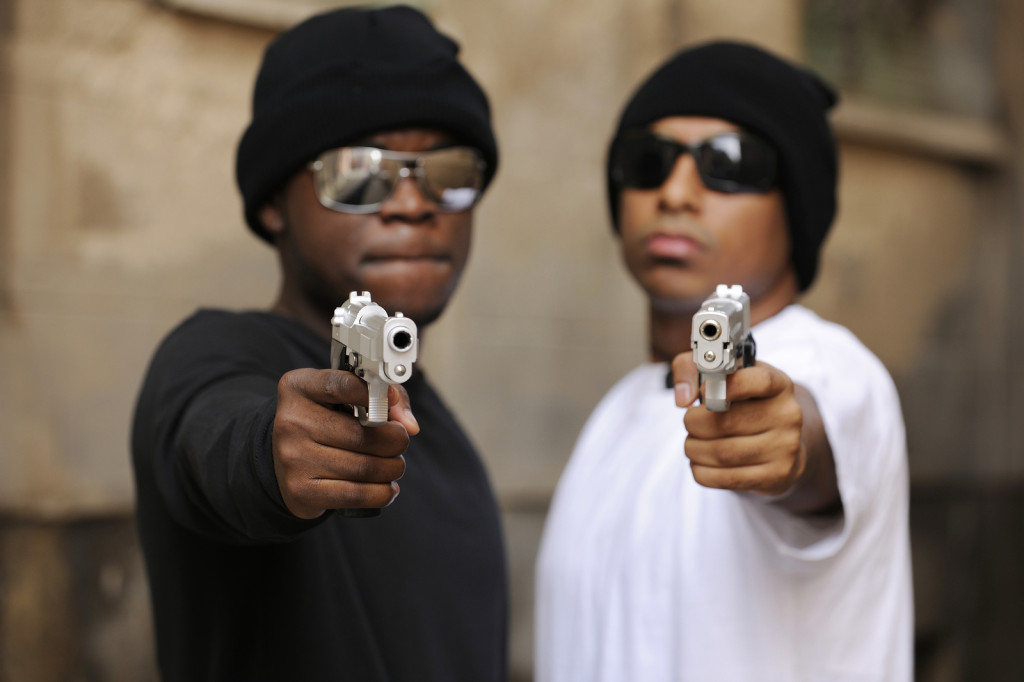
SOUTHWEST TRIBUNE
Introduction
*Study compiled by Rodney Brown at Cornell University, under the instructions of Dr. James E. Turner, Cornell University's, professor emeritus of African American Politics and Social Policy and founding director of the Africana Studies and Research Center.
First, gangs are not a creation of the black or Hispanic community. They represent only a small percentage of hard working, law abiding, black and Hispanic Americans.
Gangs has been a part of America's cultural society since, the late nineteenth-Century.
Irish, Italians, Jews, Asians and Caucasians can rightfully proclaim that a sub culture or what we commonly know as gangs existed or still exist at a point in their history.
The [Examination of Gang Psychology] is a very important social issue. Gangs, which were very popular during the early 1900's seemed to have faded at the end of the 1960's to only reemerge in the heart of popular culture today.
Gangs today has elevated from its sub cultural roots to the mainstream. As an academic tutor/mentor throughout public schools, I witness everyday how prevalent the common characteristics of gangs such as; rituals, acts of violence and erratic behavior by gang members is deteriorating our schools, malls and parks. These and other common social areas of society has been transformed into battlefields by juveniles. The point is, "gangs" are not only prevalent in Los Angeles, California anymore.
The reemergence of gangs has stagnated and marginalized the social and academic development of America's youth nationally. Because of this, not only are the streets in urbanized areas unsafe, but also our schools now share the same fate in suburban and rural areas. The dangerous activities that still rests at the very foundation of gangs has been desensitized and catapulted into the mainstream channels of America’s cultural society. Gangs are prevalent today in our streets, our schools, homes, social gathering places, and most importantly in the music our kids listen too.
Definition of gangs
Gangs are primarily male centered social activities that are formed into many separate social organizations located mostly in inner sections of large urban cities in America, though not exclusively. Because gangs are mostly male centered. Psychological implications such as; masculinity, prestige, reputation, status and identity are major factors regarding the psychological attraction of gangs. Ganging can be attributed to adolescents looking to solidify masculine identification
Gangs formed into what many sociologists have termed as Delinquent sub cultures.
Delinquent sub cultures may be observed in lower class urban areas among adolescent males. Occasionally, gangs of delinquent girls have been noted, but they're likely to be affiliated in some subordinate relationship with a group of delinquent boys. Delinquents tend to be persons who has been led to expect opportunities because of their potential ability to meet the formal, institutionally established criteria of evaluation. Their sense of injustice arises from the failure of the system to fulfill these expectations.
Richard A. Cloward and Lloyd E. Olin, two sociologists at the New York School of Social Work of Columbia University in 1960, classified gangs in three sub cultural groups.
Criminal street gangs, Conflict street gangs and Retreatist street gangs. These street gangs were classified by their characteristics such as; Criminal street gangs were classified as having 'materialistic values.' Therefore, they indulged in social activities such as; theft, robbery and extortion.
Conflict street gangs were classified as being 'territorial.' Therefore, they indulged in social activities such as: 'turf protection.'
Retreatist street gangs were classified as being 'consumers of drugs.' Retreatist street gangs felt withdrawn from contemporary society and saw themselves as the elite. These characteristics today serve as aspects of street gangs.
Today, Criminal street gangs could also be involved into Conflict street gangs activities. Just as Conflict street gangs could be involved into Criminal street gang's activities. Regarding Retreatist street gangs, there's no difference. They also share the same flexibility as Criminal and Conflict street gangs
Reasons why gangs develop
Sgt. Joe Guzman, L.A. County Sheriff Department, an expert on Hispanic street gangs stated, "Mexican gangs formed in-part due to economic conditions, prejudice and racism. Irish street gangs formed in the 1800's in New York as a result of social conditions. In the 1900's, similar economic and social factors were present in L.A. giving rise to street gangs.
Pioneers of the sociological field such as Durkheim, Merton and Cohen have conducted research and found that, "The inequalities between races in America are the main reason why gangs develop."
A recent study conducted by Anna Marie Smith, associate professor of contemporary social and political theory in the Department of Government at Cornell University uncovered startling data regarding "Inequalities" in The United States."
In her research Smith found, in the mid 1990's unemployment increased at 176% greater rate for blacks than whites. She also found, people born in the mid 1990's are more likely to remain poor than counterparts in the late 1960's and 1970's. Regarding Hispanics, she found, in the mid 1990's Hispanics replaced blacks as the poorest people in America. A Harvard University study found schools became more segregated for blacks and Hispanics and educational prospects for blacks and Hispanics were undermined as a result.
The study also suggest, a map of schools attended by the average black or Hispanic would almost perfectly match a map of "high poverty"schools.
High Poverty schools have more transient bodies, fewer teachers qualified in their subject areas, parents lacking political power, more frequent health problems among students and lower test scores. Because of these startling statistics, we can honestly say, "sub cultures or what we commonly know as gangs develops.
Gangsta Rap and Mainstream America
One of the popular pioneers of rap music is Africa Bambatta of the Zulu Nation.
Africa Bambatta, a former New York gang member, who schooled himself in the philosophies of Marcus Garvey and Malcolm X, saw rap music as a way to unify young minorities behind songs that glorifies the importance of education and becoming stewards in their respective communities to combat social injustices.
In the mid 1980's and early 90's, rap music began to broaden its scope by directly focusing more on social and political displeasure, rotted at the feet of public officials, who led and patrol their communities. This extension of rap was called Gangster Rap.
Although, the lyrics became more inflammatory and demanding, its essential component of social consciousness continued to dominate its make-up and purpose
The first Gangsta Rap group N.W.A. (Niggas with Attitudes) was started by a young man named Eric Wright from Compton, California. The music world came to know him as Eazy E. The group members consisted of Dr. Dre, Ice Cube, Emcee Ren, Emcee Yella and Eazy E.
With the creation of Music Television (MTV) and Black Entertainment Television (B.E.T.), the world got to personally witness the hurt and anxiety that stems from injustices and inequalities in African American and Hispanic communities.
Mainstream America was able to view the struggles of young men of color in their living rooms.
In 1999, 21 rap albums went platinum and 24 went gold. The startling fact is, the overwhelming majority of consumers of those albums were suburban white youth
And despite that major fact, this new audience could not directly relate to many of the issues of social injustices experienced by young men of color growing up in urban communities throughout the country.
What started in Compton, California as a cry to correct and rid their communities of social injustices and inequalities has cleared the way for Gangsta Rappers of today.
However, today's Gangsta Rappers including 2 Chainz, 21 Savage, Young Thug and Block Boy, just to name a few; are unlike their predecessors.
Instead, the lyrics in their songs are void of experiences that focus on positive identification and self-affirmation and their struggles with social injustices in their communities. And instead, glorifies historical stereotypes that has unjustly marginalized many minorities.
Large record companies and their executives are seizing the opportunity to make large sums of money by promoting today's Gangsta Rap artists and their 'brainless music' to today's minority youth based on the failing urban public education system.
The unfortunate fact, public schools across America are unabashedly graduating hundred of thousands of students every year, who are reading, writing and comprehending at the 8th grade level and lower.
The large record companies has pounce on this fact by promoting and employing artists, who themselves are academically inferior or willing to play the game because of the financial windfall.
A genre of music that was created to enlighten the world of the struggles of young minorities and illuminate paths to success, is now part of the problem with its promotion of music that neglects unjust social conditions in minority communities and illuminates paths to self-destruction, unabashedly.
Law enforcement vs. gangs in the 1960’s
Social Clubs were popular youth groupings in black communities in the early 1960's. By the mid 1960's many community social clubs saw the need to unify because of police brutality and the use of excessive force being administered in the black communities. Police brutality ignited what is known in America's urban history as the Watts Riot of 1965.
The Watts Riot gave birth to the 'Social Political Period' in African American political history. It was referred to as the Social Political Period, because of the many black political organizations that developed throughout impoverished communities of Southern California after the Watts Riot.
Ron Wilkins (ex gang member) created Community Action Patrol [C.A.P.]; which functioning purpose primarily dealt with monitoring the actions of the Los Angeles Police Department. While, William Sampson and Gerald Aubrey created more tools to prosecute gang laws.
House Bill I 30 currently sits in committee and has yet to go to vote.
Robert walker, a South Carolina-based consultant and expert on gangs said, "A few states have enacted gang specific laws. Those that use them are California, New York and Illinois, all with large metropolitan centers rife with gang activity."
In the mid 1990's nearly one in three African American men in their twenties were under some form of criminal justice supervision, either in prison or jail, on probation or on parole.
The bulk of these incarcerated men are victims of an escalating drug war against black communities. Racial disparities in sentencing were confirmed by the findings of the U.S. Sentencing Commission.
The 1990 Rand Institute Study by Peter Reuter found that financial need was the key motivating force compelling thousands of young black males to risk life, limb and imprisonment to sell illegal drugs. The vast majority of those arrested for drug dealing had jobs and used the drug profits to supplement their income
In "The State of Black Male American 1996" by Chris Booker, a quote from Hussein Abdiahi Bulhan reads, " Structural Violence" is the most lethal form of violence because it is the least discernible. It causes premature deaths in the largest number of persons. And it presents itself as the Natural Order of Things. A situation of oppression rests primarily on 'structural violence" which in turn fosters institutional, interpersonal and intrapersonal violence. The most visible indicators of structural violence are differential rates of mortality, morbidity and incarceration among groups in the same society."
Conclusion
From the material I have surveyed in my research it is clear to me that the Social Political Period that came after the Watts Riot of 1965 was a time when gang activity declined and gangs almost disappeared in California and move them toward extinction from American society. The formation of black political groups after the Watts Riot gave young blacks positive identification and self-affirmation.
Black and Hispanic Americans struggles with the issue of "masculinity."
Inequalities in The United States have fraction black and Hispanic Americans in impoverished environments that questions their manhood.
Therefore, gangs (sub cultures) are created because it's an outlet for young blacks and Hispanics males to express strength, toughness, courage, dignity and pride.
The most important opportunity that gangs offers are alternative avenues for impoverished black and Hispanic Americans to support their families financially
The obvious disparities in education, health, employment and housing and development between whites and non whites leave black and Hispanic Americans unable to improve their social and economic conditions.
Therefore, society projects young blacks and Hispanics as weak and ill-responsible. Living in poverty in a capitalistic society questions the manhood of young men; not mattering what's the color of their skin.
According to the statistics outlining the many disparities black and Hispanic males have to overcome could be the very reason why the majority don't live up to the American society traditional expectations.
Rodney Brown has received conducive educational training through extensive informative research practices that were focused on "Youth Issues," under the sponsorship of storied Universities such as Claflin University and Cornell University, where his research were delivered through visual power points and lectures in the city of Boston, Massachusetts in 2006, at large symposiums among top up-and-coming young academia and administrative staff and faculty members of Universities such as Claflin University, Cornell University, Brown University, John Hopkins University, Princeton University and Harvard University.
To book Mr. Brown for Youth related lectures and PowerPoint displays geared to illuminate paths to success, send all inquiries to: southwesttribunenewspaper@gmail.com





